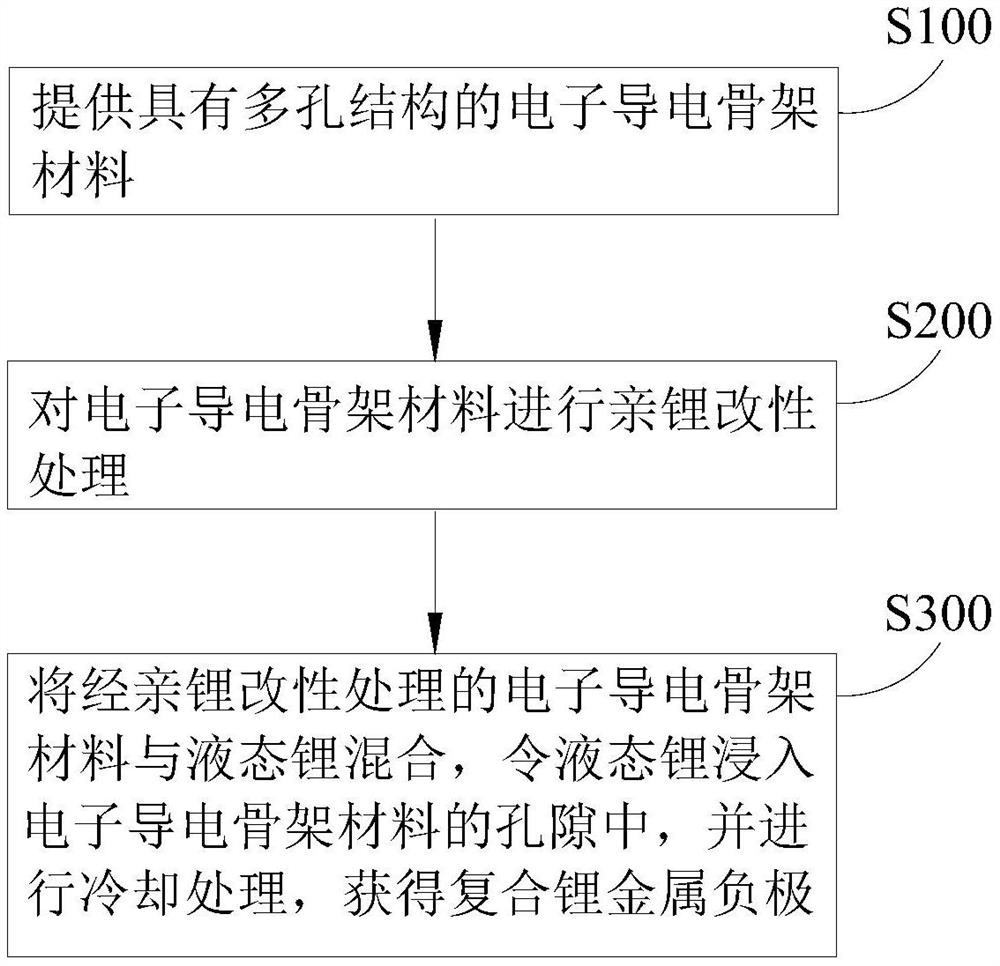Composite lithium metal negative electrode and preparation method, lithium ion battery
A metal negative electrode and lithium composite technology, applied in battery electrodes, secondary batteries, circuits, etc., can solve problems such as poor cycle performance, high safety risks, and volume expansion of lithium metal negative electrodes
- Summary
- Abstract
- Description
- Claims
- Application Information
AI Technical Summary
Problems solved by technology
Method used
Image
Examples
Embodiment 1
[0050] will have a thickness of 100 μm and a surface area of 40 cm 2 A carbon fiber paper with a porosity of 80% was immersed in a zinc nitrate solution with a concentration of 1 mol / L. After soaking for 1 hour, it was placed in a horse boiling furnace and calcined at 500°C for 30 minutes to prepare a carbon fiber skeleton material coated with zinc oxide on the surface. Heat 8.5 mg of solid lithium metal (the volume ratio of metal lithium to carbon fiber paper is 1:20) to 400°C, and obtain liquid lithium after melting. Lithium requirements. Carbon fiber paper is placed on the surface of liquid lithium, and liquid lithium spontaneously diffuses to the surface of the carbon fiber paper skeleton and immerses in the pores of the carbon fiber paper skeleton. After cooling, the composite lithium metal negative electrode is obtained, and its lithium content is 0.21mg / cm 2 , the porosity is 76%.
[0051] The above-mentioned composite lithium metal is used as the negative electrod...
Embodiment 2
[0053] Set the thickness to 50μm and the area to 40cm 2 A nickel foam with a porosity of 70% is immersed in a zinc nitrate solution with a concentration of 0.5 mol / L. After soaking for 1 hour, it is put into a horse boiling furnace and calcined at 500° C. for 30 minutes to prepare a nickel foam skeleton material coated with zinc oxide on the surface. Heat 7.5mg of solid lithium metal (volume ratio of metal lithium to nickel foam 1:10) to 500°C, and obtain liquid lithium after melting. The amount of lithium metal obtained according to the above volume ratio meets the lithium content of the composite lithium metal negative electrode requirements. The nickel foam is placed on the surface of the liquid lithium, and the liquid lithium spontaneously diffuses to the surface of the nickel foam skeleton and immerses into the pores of the nickel foam skeleton. After cooling, the composite lithium metal negative electrode is obtained, and its lithium content is 0.19mg / cm 2 , the porosi...
Embodiment 3
[0056] Set the thickness to 100μm and the area to 20cm 2 A copper foam with a porosity of 70% was immersed in a 0.1 mol / L tetraethyl orthosilicate solution, soaked for 1 hour, and then heated and dried to prepare a copper foam skeleton material coated with silicon dioxide on the surface. Heat 14.9mg of solid lithium metal (volume ratio of metal lithium to nickel foam 1:5) to 350°C, and obtain liquid lithium after melting. The amount of lithium metal obtained according to the above volume ratio meets the lithium content of the composite lithium metal negative electrode requirements. The copper foam is placed on the surface of the liquid lithium, and the liquid lithium spontaneously diffuses to the surface of the copper foam skeleton and immerses into the pores of the copper foam skeleton. After cooling, the composite lithium metal negative electrode is obtained, and its lithium content is 0.75mg / cm 2 , the porosity is 56%.
[0057] The composite lithium metal negative electr...
PUM
| Property | Measurement | Unit |
|---|---|---|
| thickness | aaaaa | aaaaa |
| thickness | aaaaa | aaaaa |
| area | aaaaa | aaaaa |
Abstract
Description
Claims
Application Information
 Login to View More
Login to View More - R&D
- Intellectual Property
- Life Sciences
- Materials
- Tech Scout
- Unparalleled Data Quality
- Higher Quality Content
- 60% Fewer Hallucinations
Browse by: Latest US Patents, China's latest patents, Technical Efficacy Thesaurus, Application Domain, Technology Topic, Popular Technical Reports.
© 2025 PatSnap. All rights reserved.Legal|Privacy policy|Modern Slavery Act Transparency Statement|Sitemap|About US| Contact US: help@patsnap.com

